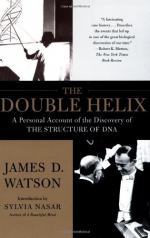
|
| Name: _________________________ | Period: ___________________ |
This test consists of 15 multiple choice questions and 5 short answer questions.
Multiple Choice Questions
1. How did Watson feel about Rosy's reaction to the new model?
(a) Surprised
(b) Rejected
(c) Angered
(d) Awed
2. What topic was Linus Pauling studying?
(a) How protein coils did not make helixes
(b) How to build a model of DNA
(c) How protein helixes created coils within coils
(d) Why bacteria were able to reproduce
3. How did Watson spend the time while he waited for the machine shop to construct the necessary parts?
(a) Creating bacteria studies
(b) Making RNA models
(c) Talking with his sister and her beau
(d) Non-work-related activities
4. What had the Cavendish lab recently discovered?
(a) A model of DNA and RNA
(b) The structure of RNA
(c) A new kind of X-ray tube
(d) The structure of DNA
5. Who confirmed Watson's finding that TMV was indeed a helix?
(a) Maurice
(b) Crick
(c) Rosy
(d) Pauling
6. Who did Pauling give copies of his manuscript which contained his new model of DNA?
(a) Rosy and Bragg
(b) Rosy and Maurice
(c) Watson and Crick
(d) Peter and Bragg
7. Which two components of DNA did Chargaff find had the same number of molecules?
(a) guanine and thymine
(b) guanine and adenine
(c) adenine and thymine
(d) cytosine and thymine
8. What event diffused the tension and heat between Rosy and Watson?
(a) Rosy assaulting Watson
(b) Watson walking out of the lab
(c) Rosy tearing up Pauling's work
(d) Maurice entering the lab
9. Which of the following did Watson begin working on after being told to stop his work on DNA?
(a) TMZ
(b) TMV
(c) MTV
(d) VMT
10. What did Watson believe caused the medical condition from which he was suffering?
(a) Worry over DNA
(b) Spicy food
(c) Too much work
(d) Pressure from his PhD program
11. On what form of DNA did Crick work?
(a) D form
(b) B form
(c) A form
(d) C form
12. Where had Watson moved?
(a) Clare College
(b) Portugal Place
(c) Fish place
(d) Cambridge College
13. Which of the following was why Pauling never arrived in London?
(a) Political views
(b) Incomplete travel records
(c) Breakthrough in his projects
(d) Health issues
14. How much faster was Watson able to take pictures with the new X-ray tube?
(a) 30 times
(b) 5 times
(c) 20 times
(d) 10 times
15. How old was Rosy when she died?
(a) 25
(b) 60
(c) 37
(d) 54
Short Answer Questions
1. What was wrong with Maurice at the meeting in Paris?
2. How much progress did Crick make?
3. What happened when King's lab began comparing their experimental results to the double helix structure?
4. When would Watson go to Cal-Tech?
5. Where was Pauling's lab?
|
This section contains 434 words (approx. 2 pages at 300 words per page) |

|




